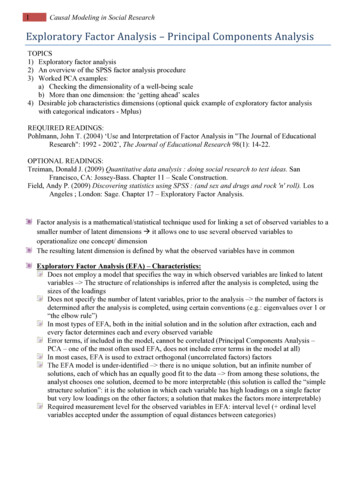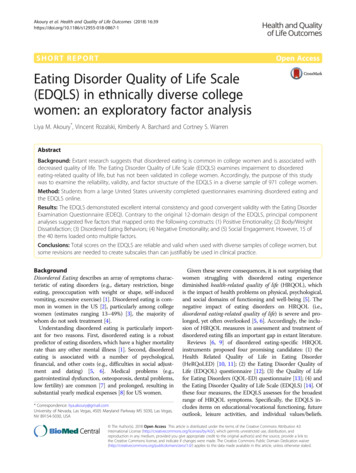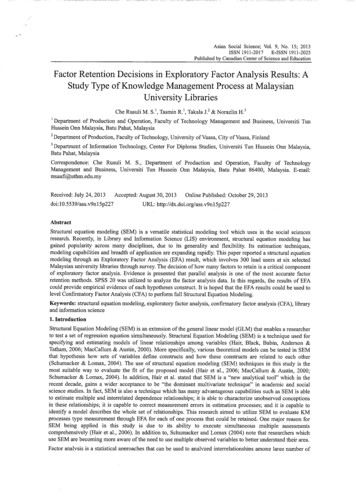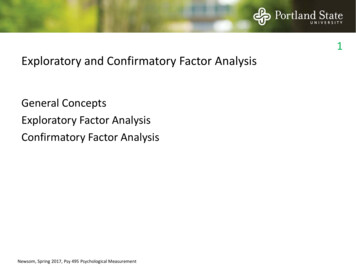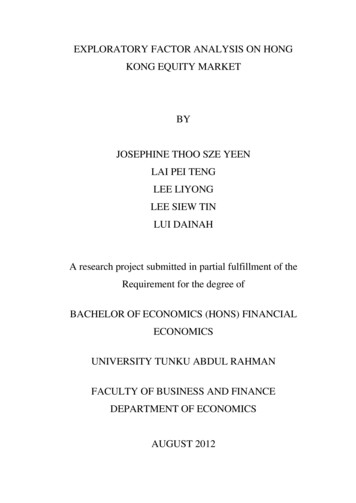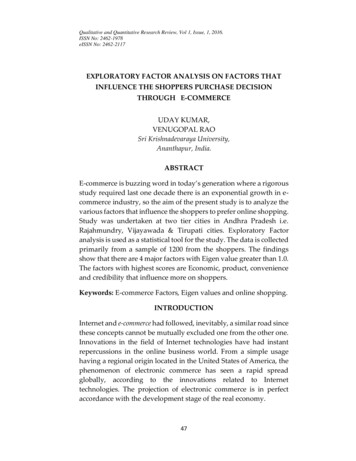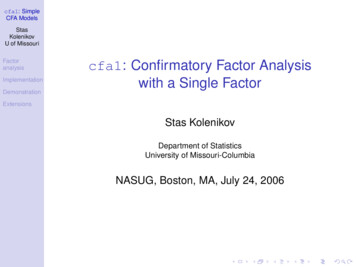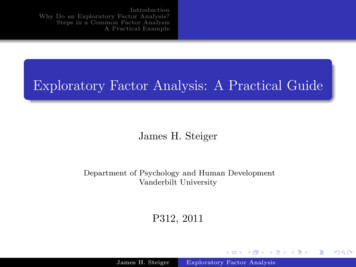
Transcription
IntroductionWhy Do an Exploratory Factor Analysis?Steps in a Common Factor AnalysisA Practical ExampleExploratory Factor Analysis: A Practical GuideJames H. SteigerDepartment of Psychology and Human DevelopmentVanderbilt UniversityP312, 2011James H. SteigerExploratory Factor Analysis
IntroductionWhy Do an Exploratory Factor Analysis?Steps in a Common Factor AnalysisA Practical ExampleExploratory Factor Analysis: A Practical Guide1Introduction2Why Do an Exploratory Factor Analysis?Structural ExplorationStructural ConfirmationData Reduction and Attribute Scoring3Steps in a Common Factor AnalysisDesign the StudyGather the DataChoose the ModelSelect m, the Number of FactorsRotate the FactorsInterpret and Name the Factors4A Practical ExampleJames H. SteigerExploratory Factor Analysis
IntroductionWhy Do an Exploratory Factor Analysis?Steps in a Common Factor AnalysisA Practical ExampleIntroductionFactor Analysis is an important and widely usedmultivariate method.A number of techniques are referred to as “factor analysismethods,” but experts currently concentrate primarily ontwo approaches, which we will refer to as common factoranalysis and principal component analysis.People have been arguing the relative theoretical merits ofthese methods for many years, often with considerableego-investment and with no shortage of vitriol.Interestingly, a significant percentage of the time thefundamental substantive conclusions from a common factoranalysis and a component analysis will be very similar.Proponents of the common factor model often presentexamples built around data sets (authentic or artificial)that fit the common factor model well, then expound onthe fact that the solutions obtained by component analysisdiffers from that obtained by factor analysis.I’m not sure how seriously we should take thesedemonstrations, but I think we need to keep an open mind.In this lecture, we’ll cover the basics of exploratory factoranalysis using R.James H. SteigerExploratory Factor Analysis
IntroductionWhy Do an Exploratory Factor Analysis?Steps in a Common Factor AnalysisA Practical ExampleIntroductionFactor Analysis is an important and widely usedmultivariate method.A number of techniques are referred to as “factor analysismethods,” but experts currently concentrate primarily ontwo approaches, which we will refer to as common factoranalysis and principal component analysis.People have been arguing the relative theoretical merits ofthese methods for many years, often with considerableego-investment and with no shortage of vitriol.Interestingly, a significant percentage of the time thefundamental substantive conclusions from a common factoranalysis and a component analysis will be very similar.Proponents of the common factor model often presentexamples built around data sets (authentic or artificial)that fit the common factor model well, then expound onthe fact that the solutions obtained by component analysisdiffers from that obtained by factor analysis.I’m not sure how seriously we should take thesedemonstrations, but I think we need to keep an open mind.In this lecture, we’ll cover the basics of exploratory factoranalysis using R.James H. SteigerExploratory Factor Analysis
IntroductionWhy Do an Exploratory Factor Analysis?Steps in a Common Factor AnalysisA Practical ExampleIntroductionFactor Analysis is an important and widely usedmultivariate method.A number of techniques are referred to as “factor analysismethods,” but experts currently concentrate primarily ontwo approaches, which we will refer to as common factoranalysis and principal component analysis.People have been arguing the relative theoretical merits ofthese methods for many years, often with considerableego-investment and with no shortage of vitriol.Interestingly, a significant percentage of the time thefundamental substantive conclusions from a common factoranalysis and a component analysis will be very similar.Proponents of the common factor model often presentexamples built around data sets (authentic or artificial)that fit the common factor model well, then expound onthe fact that the solutions obtained by component analysisdiffers from that obtained by factor analysis.I’m not sure how seriously we should take thesedemonstrations, but I think we need to keep an open mind.In this lecture, we’ll cover the basics of exploratory factoranalysis using R.James H. SteigerExploratory Factor Analysis
IntroductionWhy Do an Exploratory Factor Analysis?Steps in a Common Factor AnalysisA Practical ExampleIntroductionFactor Analysis is an important and widely usedmultivariate method.A number of techniques are referred to as “factor analysismethods,” but experts currently concentrate primarily ontwo approaches, which we will refer to as common factoranalysis and principal component analysis.People have been arguing the relative theoretical merits ofthese methods for many years, often with considerableego-investment and with no shortage of vitriol.Interestingly, a significant percentage of the time thefundamental substantive conclusions from a common factoranalysis and a component analysis will be very similar.Proponents of the common factor model often presentexamples built around data sets (authentic or artificial)that fit the common factor model well, then expound onthe fact that the solutions obtained by component analysisdiffers from that obtained by factor analysis.I’m not sure how seriously we should take thesedemonstrations, but I think we need to keep an open mind.In this lecture, we’ll cover the basics of exploratory factoranalysis using R.James H. SteigerExploratory Factor Analysis
IntroductionWhy Do an Exploratory Factor Analysis?Steps in a Common Factor AnalysisA Practical ExampleIntroductionFactor Analysis is an important and widely usedmultivariate method.A number of techniques are referred to as “factor analysismethods,” but experts currently concentrate primarily ontwo approaches, which we will refer to as common factoranalysis and principal component analysis.People have been arguing the relative theoretical merits ofthese methods for many years, often with considerableego-investment and with no shortage of vitriol.Interestingly, a significant percentage of the time thefundamental substantive conclusions from a common factoranalysis and a component analysis will be very similar.Proponents of the common factor model often presentexamples built around data sets (authentic or artificial)that fit the common factor model well, then expound onthe fact that the solutions obtained by component analysisdiffers from that obtained by factor analysis.I’m not sure how seriously we should take thesedemonstrations, but I think we need to keep an open mind.In this lecture, we’ll cover the basics of exploratory factoranalysis using R.James H. SteigerExploratory Factor Analysis
IntroductionWhy Do an Exploratory Factor Analysis?Steps in a Common Factor AnalysisA Practical ExampleIntroductionFactor Analysis is an important and widely usedmultivariate method.A number of techniques are referred to as “factor analysismethods,” but experts currently concentrate primarily ontwo approaches, which we will refer to as common factoranalysis and principal component analysis.People have been arguing the relative theoretical merits ofthese methods for many years, often with considerableego-investment and with no shortage of vitriol.Interestingly, a significant percentage of the time thefundamental substantive conclusions from a common factoranalysis and a component analysis will be very similar.Proponents of the common factor model often presentexamples built around data sets (authentic or artificial)that fit the common factor model well, then expound onthe fact that the solutions obtained by component analysisdiffers from that obtained by factor analysis.I’m not sure how seriously we should take thesedemonstrations, but I think we need to keep an open mind.In this lecture, we’ll cover the basics of exploratory factoranalysis using R.James H. SteigerExploratory Factor Analysis
IntroductionWhy Do an Exploratory Factor Analysis?Steps in a Common Factor AnalysisA Practical ExampleIntroductionFactor Analysis is an important and widely usedmultivariate method.A number of techniques are referred to as “factor analysismethods,” but experts currently concentrate primarily ontwo approaches, which we will refer to as common factoranalysis and principal component analysis.People have been arguing the relative theoretical merits ofthese methods for many years, often with considerableego-investment and with no shortage of vitriol.Interestingly, a significant percentage of the time thefundamental substantive conclusions from a common factoranalysis and a component analysis will be very similar.Proponents of the common factor model often presentexamples built around data sets (authentic or artificial)that fit the common factor model well, then expound onthe fact that the solutions obtained by component analysisdiffers from that obtained by factor analysis.I’m not sure how seriously we should take thesedemonstrations, but I think we need to keep an open mind.In this lecture, we’ll cover the basics of exploratory factoranalysis using R.James H. SteigerExploratory Factor Analysis
IntroductionWhy Do an Exploratory Factor Analysis?Steps in a Common Factor AnalysisA Practical ExampleStructural ExplorationStructural ConfirmationData Reduction and Attribute ScoringWhy Do an Exploratory Factor Analysis?Structural ExplorationStructural ConfirmationData ReductionAttribute ScoringJames H. SteigerExploratory Factor Analysis
IntroductionWhy Do an Exploratory Factor Analysis?Steps in a Common Factor AnalysisA Practical ExampleStructural ExplorationStructural ConfirmationData Reduction and Attribute ScoringWhy Do an Exploratory Factor Analysis?Structural ExplorationStructural ConfirmationData ReductionAttribute ScoringJames H. SteigerExploratory Factor Analysis
IntroductionWhy Do an Exploratory Factor Analysis?Steps in a Common Factor AnalysisA Practical ExampleStructural ExplorationStructural ConfirmationData Reduction and Attribute ScoringWhy Do an Exploratory Factor Analysis?Structural ExplorationStructural ConfirmationData ReductionAttribute ScoringJames H. SteigerExploratory Factor Analysis
IntroductionWhy Do an Exploratory Factor Analysis?Steps in a Common Factor AnalysisA Practical ExampleStructural ExplorationStructural ConfirmationData Reduction and Attribute ScoringWhy Do an Exploratory Factor Analysis?Structural ExplorationStructural ConfirmationData ReductionAttribute ScoringJames H. SteigerExploratory Factor Analysis
IntroductionWhy Do an Exploratory Factor Analysis?Steps in a Common Factor AnalysisA Practical ExampleStructural ExplorationStructural ConfirmationData Reduction and Attribute ScoringStructural ExplorationThe two main factor analytic models can both be writteny Fx e(1)The factor pattern F is the set of linear weights carryingthe (small number of) factors (or components) into thelarger number of observed variables. If, for the p mmatrix F , p is substantially larger then m, we may be ableto attain several data analysis goals at once.First, the idea emerges that this compact F may be “amodel for what underlies y.” A number of authors (mostnotably of late, the statistician and philosopher of scienceMichael Maraun) have severely criticized the ubiquity ofthis idea and its logical foundations. But if you accept theidea, then the form of F may reveal important aspects ofthe structure of the variance in a domain of content.In this course, we’ll try to have our cake, and eat it too.We’ll learn to interpret a factor pattern while remainingvery cautious and skeptical about the factor analysismodeling enterprise.James H. SteigerExploratory Factor Analysis
IntroductionWhy Do an Exploratory Factor Analysis?Steps in a Common Factor AnalysisA Practical ExampleStructural ExplorationStructural ConfirmationData Reduction and Attribute ScoringStructural ExplorationThe two main factor analytic models can both be writteny Fx e(1)The factor pattern F is the set of linear weights carryingthe (small number of) factors (or components) into thelarger number of observed variables. If, for the p mmatrix F , p is substantially larger then m, we may be ableto attain several data analysis goals at once.First, the idea emerges that this compact F may be “amodel for what underlies y.” A number of authors (mostnotably of late, the statistician and philosopher of scienceMichael Maraun) have severely criticized the ubiquity ofthis idea and its logical foundations. But if you accept theidea, then the form of F may reveal important aspects ofthe structure of the variance in a domain of content.In this course, we’ll try to have our cake, and eat it too.We’ll learn to interpret a factor pattern while remainingvery cautious and skeptical about the factor analysismodeling enterprise.James H. SteigerExploratory Factor Analysis
IntroductionWhy Do an Exploratory Factor Analysis?Steps in a Common Factor AnalysisA Practical ExampleStructural ExplorationStructural ConfirmationData Reduction and Attribute ScoringStructural ExplorationThe two main factor analytic models can both be writteny Fx e(1)The factor pattern F is the set of linear weights carryingthe (small number of) factors (or components) into thelarger number of observed variables. If, for the p mmatrix F , p is substantially larger then m, we may be ableto attain several data analysis goals at once.First, the idea emerges that this compact F may be “amodel for what underlies y.” A number of authors (mostnotably of late, the statistician and philosopher of scienceMichael Maraun) have severely criticized the ubiquity ofthis idea and its logical foundations. But if you accept theidea, then the form of F may reveal important aspects ofthe structure of the variance in a domain of content.In this course, we’ll try to have our cake, and eat it too.We’ll learn to interpret a factor pattern while remainingvery cautious and skeptical about the factor analysismodeling enterprise.James H. SteigerExploratory Factor Analysis
IntroductionWhy Do an Exploratory Factor Analysis?Steps in a Common Factor AnalysisA Practical ExampleStructural ExplorationStructural ConfirmationData Reduction and Attribute ScoringStructural ExplorationThe two main factor analytic models can both be writteny Fx e(1)The factor pattern F is the set of linear weights carryingthe (small number of) factors (or components) into thelarger number of observed variables. If, for the p mmatrix F , p is substantially larger then m, we may be ableto attain several data analysis goals at once.First, the idea emerges that this compact F may be “amodel for what underlies y.” A number of authors (mostnotably of late, the statistician and philosopher of scienceMichael Maraun) have severely criticized the ubiquity ofthis idea and its logical foundations. But if you accept theidea, then the form of F may reveal important aspects ofthe structure of the variance in a domain of content.In this course, we’ll try to have our cake, and eat it too.We’ll learn to interpret a factor pattern while remainingvery cautious and skeptical about the factor analysismodeling enterprise.James H. SteigerExploratory Factor Analysis
IntroductionWhy Do an Exploratory Factor Analysis?Steps in a Common Factor AnalysisA Practical ExampleStructural ExplorationStructural ConfirmationData Reduction and Attribute ScoringStructural ConfirmationIn some situations, you expect to find a certain structure inyour multivariate data.An exploratory factor analysis (depending on how it turnsout) can confirm these expectations.Such expectations may be approached in a more formalway with so-called confirmatory factor analysis methods,which we’ll examine in detail in a later lecture.James H. SteigerExploratory Factor Analysis
IntroductionWhy Do an Exploratory Factor Analysis?Steps in a Common Factor AnalysisA Practical ExampleStructural ExplorationStructural ConfirmationData Reduction and Attribute ScoringStructural ConfirmationIn some situations, you expect to find a certain structure inyour multivariate data.An exploratory factor analysis (depending on how it turnsout) can confirm these expectations.Such expectations may be approached in a more formalway with so-called confirmatory factor analysis methods,which we’ll examine in detail in a later lecture.James H. SteigerExploratory Factor Analysis
IntroductionWhy Do an Exploratory Factor Analysis?Steps in a Common Factor AnalysisA Practical ExampleStructural ExplorationStructural ConfirmationData Reduction and Attribute ScoringStructural ConfirmationIn some situations, you expect to find a certain structure inyour multivariate data.An exploratory factor analysis (depending on how it turnsout) can confirm these expectations.Such expectations may be approached in a more formalway with so-called confirmatory factor analysis methods,which we’ll examine in detail in a later lecture.James H. SteigerExploratory Factor Analysis
IntroductionWhy Do an Exploratory Factor Analysis?Steps in a Common Factor AnalysisA Practical ExampleStructural ExplorationStructural ConfirmationData Reduction and Attribute ScoringData ReductionOne important potential use for factor analytic methods isdata reduction.If you have a large number of variables, and a relativelysmall number of observations, then it is quite likely that anumber of dimensions in your data are redundant.Many variables may, essentially, be unreliable measures ofthe same construct.As we learn in courses on measurement, linear combination(even simple summing) of a number of unreliable measuresof a construct can yield a more reliable measure of theconstruct, and reduce the number of variables in theanalysis from several to one.This principle allows factor analysis methods to yield scalescores for those factors that appear to coincide withimportant attributes.James H. SteigerExploratory Factor Analysis
IntroductionWhy Do an Exploratory Factor Analysis?Steps in a Common Factor AnalysisA Practical ExampleStructural ExplorationStructural ConfirmationData Reduction and Attribute ScoringData ReductionOne important potential use for factor analytic methods isdata reduction.If you have a large number of variables, and a relativelysmall number of observations, then it is quite likely that anumber of dimensions in your data are redundant.Many variables may, essentially, be unreliable measures ofthe same construct.As we learn in courses on measurement, linear combination(even simple summing) of a number of unreliable measuresof a construct can yield a more reliable measure of theconstruct, and reduce the number of variables in theanalysis from several to one.This principle allows factor analysis methods to yield scalescores for those factors that appear to coincide withimportant attributes.James H. SteigerExploratory Factor Analysis
IntroductionWhy Do an Exploratory Factor Analysis?Steps in a Common Factor AnalysisA Practical ExampleStructural ExplorationStructural ConfirmationData Reduction and Attribute ScoringData ReductionOne important potential use for factor analytic methods isdata reduction.If you have a large number of variables, and a relativelysmall number of observations, then it is quite likely that anumber of dimensions in your data are redundant.Many variables may, essentially, be unreliable measures ofthe same construct.As we learn in courses on measurement, linear combination(even simple summing) of a number of unreliable measuresof a construct can yield a more reliable measure of theconstruct, and reduce the number of variables in theanalysis from several to one.This principle allows factor analysis methods to yield scalescores for those factors that appear to coincide withimportant attributes.James H. SteigerExploratory Factor Analysis
IntroductionWhy Do an Exploratory Factor Analysis?Steps in a Common Factor AnalysisA Practical ExampleStructural ExplorationStructural ConfirmationData Reduction and Attribute ScoringData ReductionOne important potential use for factor analytic methods isdata reduction.If you have a large number of variables, and a relativelysmall number of observations, then it is quite likely that anumber of dimensions in your data are redundant.Many variables may, essentially, be unreliable measures ofthe same construct.As we learn in courses on measurement, linear combination(even simple summing) of a number of unreliable measuresof a construct can yield a more reliable measure of theconstruct, and reduce the number of variables in theanalysis from several to one.This principle allows factor analysis methods to yield scalescores for those factors that appear to coincide withimportant attributes.James H. SteigerExploratory Factor Analysis
IntroductionWhy Do an Exploratory Factor Analysis?Steps in a Common Factor AnalysisA Practical ExampleStructural ExplorationStructural ConfirmationData Reduction and Attribute ScoringData ReductionOne important potential use for factor analytic methods isdata reduction.If you have a large number of variables, and a relativelysmall number of observations, then it is quite likely that anumber of dimensions in your data are redundant.Many variables may, essentially, be unreliable measures ofthe same construct.As we learn in courses on measurement, linear combination(even simple summing) of a number of unreliable measuresof a construct can yield a more reliable measure of theconstruct, and reduce the number of variables in theanalysis from several to one.This principle allows factor analysis methods to yield scalescores for those factors that appear to coincide withimportant attributes.James H. SteigerExploratory Factor Analysis
IntroductionWhy Do an Exploratory Factor Analysis?Steps in a Common Factor AnalysisA Practical ExampleDesign the StudyGather the DataChoose the ModelSelect m, the Number of FactorsRotate the FactorsInterpret and Name the FactorsSteps in a Common Factor AnalysisDesign the StudyGather the DataChoose the ModelSelect m, the Number of FactorsRotate the FactorsInterpret the Factors and Name ThemObtain Scale ScoresJames H. SteigerExploratory Factor Analysis
IntroductionWhy Do an Exploratory Factor Analysis?Steps in a Common Factor AnalysisA Practical ExampleDesign the StudyGather the DataChoose the ModelSelect m, the Number of FactorsRotate the FactorsInterpret and Name the FactorsSteps in a Common Factor AnalysisDesign the StudyGather the DataChoose the ModelSelect m, the Number of FactorsRotate the FactorsInterpret the Factors and Name ThemObtain Scale ScoresJames H. SteigerExploratory Factor Analysis
IntroductionWhy Do an Exploratory Factor Analysis?Steps in a Common Factor AnalysisA Practical ExampleDesign the StudyGather the DataChoose the ModelSelect m, the Number of FactorsRotate the FactorsInterpret and Name the FactorsSteps in a Common Factor AnalysisDesign the StudyGather the DataChoose the ModelSelect m, the Number of FactorsRotate the FactorsInterpret the Factors and Name ThemObtain Scale ScoresJames H. SteigerExploratory Factor Analysis
IntroductionWhy Do an Exploratory Factor Analysis?Steps in a Common Factor AnalysisA Practical ExampleDesign the StudyGather the DataChoose the ModelSelect m, the Number of FactorsRotate the FactorsInterpret and Name the FactorsSteps in a Common Factor AnalysisDesign the StudyGather the DataChoose the ModelSelect m, the Number of FactorsRotate the FactorsInterpret the Factors and Name ThemObtain Scale ScoresJames H. SteigerExploratory Factor Analysis
IntroductionWhy Do an Exploratory Factor Analysis?Steps in a Common Factor AnalysisA Practical ExampleDesign the StudyGather the DataChoose the ModelSelect m, the Number of FactorsRotate the FactorsInterpret and Name the FactorsSteps in a Common Factor AnalysisDesign the StudyGather the DataChoose the ModelSelect m, the Number of FactorsRotate the FactorsInterpret the Factors and Name ThemObtain Scale ScoresJames H. SteigerExploratory Factor Analysis
IntroductionWhy Do an Exploratory Factor Analysis?Steps in a Common Factor AnalysisA Practical ExampleDesign the StudyGather the DataChoose the ModelSelect m, the Number of FactorsRotate the FactorsInterpret and Name the FactorsSteps in a Common Factor AnalysisDesign the StudyGather the DataChoose the ModelSelect m, the Number of FactorsRotate the FactorsInterpret the Factors and Name ThemObtain Scale ScoresJames H. SteigerExploratory Factor Analysis
IntroductionWhy Do an Exploratory Factor Analysis?Steps in a Common Factor AnalysisA Practical ExampleDesign the StudyGather the DataChoose the ModelSelect m, the Number of FactorsRotate the FactorsInterpret and Name the FactorsSteps in a Common Factor AnalysisDesign the StudyGather the DataChoose the ModelSelect m, the Number of FactorsRotate the FactorsInterpret the Factors and Name ThemObtain Scale ScoresJames H. SteigerExploratory Factor Analysis
IntroductionWhy Do an Exploratory Factor Analysis?Steps in a Common Factor AnalysisA Practical ExampleDesign the StudyGather the DataChoose the ModelSelect m, the Number of FactorsRotate the FactorsInterpret and Name the FactorsDesign the StudyChoose the domain of contentAnalyze its facetsTry to have at least 3–4 items per facetPerform power and sample size analysisJames H. SteigerExploratory Factor Analysis
IntroductionWhy Do an Exploratory Factor Analysis?Steps in a Common Factor AnalysisA Practical ExampleDesign the StudyGather the DataChoose the ModelSelect m, the Number of FactorsRotate the FactorsInterpret and Name the FactorsDesign the StudyChoose the domain of contentAnalyze its facetsTry to have at least 3–4 items per facetPerform power and sample size analysisJames H. SteigerExploratory Factor Analysis
IntroductionWhy Do an Exploratory Factor Analysis?Steps in a Common Factor AnalysisA Practical ExampleDesign the StudyGather the DataChoose the ModelSelect m, the Number of FactorsRotate the FactorsInterpret and Name the FactorsDesign the StudyChoose the domain of contentAnalyze its facetsTry to have at least 3–4 items per facetPerform power and sample size analysisJames H. SteigerExploratory Factor Analysis
IntroductionWhy Do an Exploratory Factor Analysis?Steps in a Common Factor AnalysisA Practical ExampleDesign the StudyGather the DataChoose the ModelSelect m, the Number of FactorsRotate the FactorsInterpret and Name the FactorsDesign the StudyChoose the domain of contentAnalyze its facetsTry to have at least 3–4 items per facetPerform power and sample size analysisJames H. SteigerExploratory Factor Analysis
IntroductionWhy Do an Exploratory Factor Analysis?Steps in a Common Factor AnalysisA Practical ExampleDesign the StudyGather the DataChoose the ModelSelect m, the Number of FactorsRotate the FactorsInterpret and Name the FactorsPower and Sample Size AnalysisA factor analysis involves two fundamental kinds of power andsample size analysis.One must have adequate sample size to accurately assess:Overall model fitAccuracy of parameter estimatesLikelihood of Heywood cases (in the event common factoranalysis is chosen)James H. SteigerExploratory Factor Analysis
IntroductionWhy Do an Exploratory Factor Analysis?Steps in a Common Factor AnalysisA Practical ExampleDesign the StudyGather the DataChoose the ModelSelect m, the Number of FactorsRotate the FactorsInterpret and Name the FactorsPower and Sample Size AnalysisA factor analysis involves two fundamental kinds of power andsample size analysis.One must have adequate sample size to accurately assess:Overall model fitAccuracy of parameter estimatesLikelihood of Heywood cases (in the event common factoranalysis is chosen)James H. SteigerExploratory Factor Analysis
IntroductionWhy Do an Exploratory Factor Analysis?Steps in a Common Factor AnalysisA Practical ExampleDesign the StudyGather the DataChoose the ModelSelect m, the Number of FactorsRotate the FactorsInterpret and Name the FactorsPower and Sample Size AnalysisA factor analysis involves two fundamental kinds of power andsample size analysis.One must have adequate sample size to accurately assess:Overall model fitAccuracy of parameter estimatesLikelihood of Heywood cases (in the event common factoranalysis is chosen)James H. SteigerExploratory Factor Analysis
IntroductionWhy Do an Exploratory Factor Analysis?Steps in a Common Factor AnalysisA Practical ExampleDesign the StudyGather the DataChoose the ModelSelect m, the Number of FactorsRotate the FactorsInterpret and Name the FactorsGather the DataIt may take weeks, months, or even years to gather the datarequired to factor analyze a significant domain of behavior.False starts can be very costly.Always remember the problem of spurious correlations, andavoid combining males and females, or identifiablesubgroups with significantly different mean or covariancestructures.On the other hand, actively consider whether a conveniencesample might produce false conclusions because it is notsufficiently representative of the population of interest.James H. SteigerExploratory Factor Analysis
IntroductionWhy Do an Exploratory Factor Analysis?Steps in a Common Factor AnalysisA Practical ExampleDesign the StudyGather the DataChoose the ModelSelect m, the Number of FactorsRotate the FactorsInterpret and Name the FactorsGather the DataIt may take weeks, months, or even years to gather the datarequired to factor analyze a significant domain of behavior.False starts can be very costly.Always remember the problem of spurious correlations, andavoid combining males and females, or identifiablesubgroups with significantly different mean or covariancestructures.On the other hand, actively consider whether a conveniencesample might produce false conclusions because it is notsufficiently representative of the population of interest.James H. Steige
2 Why Do an Exploratory Factor Analysis? Structural Exploration Structural Con rmation Data Reduction and Attribute Scoring 3 Steps in a Common Factor Analysis Design the Study Gather the Data Choose the Model Select m, the Number of Factors Rotate the Factors Interpret and Name the Factors 4 A Practical Example James H. Steiger Exploratory .
